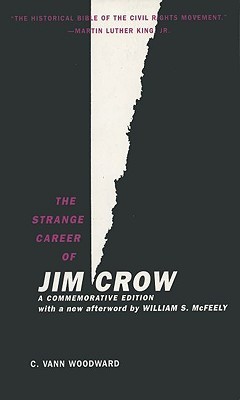What do you think?
Rate this book


C. Vann Woodward, who died in 1999 at the age of 91, was America's most eminent Southern historian, the winner of a Pulitzer Prize for Mary Chestnut's Civil War and a Bancroft Prize for The Origins of the New South. Now, to honor his long and truly distinguished career, Oxford is pleased to publish this special commemorative edition of Woodward's most influential work, The Strange Career of Jim Crow.
The Strange Career of Jim Crow is one of the great works of Southern history. Indeed, the book actually helped shape that history. Published in 1955, a year after the Supreme Court in Brown v. Board of Education ordered schools desegregated, Strange Career was cited so often to counter arguments for segregation that Martin Luther King, Jr. called it "the historical Bible of the civil rights movement." The book offers a clear and illuminating analysis of the history of Jim Crow laws, presenting evidence that segregation in the South dated only to the 1890s. Woodward convincingly shows that, even under slavery, the two races had not been divided as they were under the Jim Crow laws of the 1890s. In fact, during Reconstruction, there was considerable economic and political mixing of the races. The segregating of the races was a relative newcomer to the region.
Hailed as one of the top 100 nonfiction works of the twentieth century, The Strange Career of Jim Crow has sold almost a million copies and remains, in the words of David Herbert Donald, "a landmark in the history of American race relations."
245 pages, Paperback
First published February 1, 1955
’As we have got on fairly well for a third of century, including a long period of reconstruction, without such a measure,’ wrote the editor, ‘we can probably get on as well hereafter without it, and certainly so extreme a measure should not be adopted and enforced without added and urgent cause.’ He then called attention to what he considered the absurd consequences to which such a law might lead once the principle of the thing were conceded. ‘If there must be Jim Crow cars on the railroads, there should be Jim Crow cars on the street railways. Also on all passenger boats … If there are to be Jim Crow cars, moreover, there should be Jim Crow waiting saloons at all stations, and Jim Crow eating houses … There should be Jim Crow sections of a jury box, and a separate Jim crow dock and witness stand in every court – and a Jim Crow Bible for colored witnesses to kiss. It would be advisable also to have a Jim Crow section in county auditors’ and treasurers’ offices for the accommodation of colored taxpayers. The two races are dreadfully mixed in these offices for weeks every year, especially about Christmas … There should be a Jim Crow department for making returns and paying for the privileges and blessings of citizenship. Perhaps the best plan would be, after all, to take the short cut to the general end … by establishing two or three Jim Crow counties at once, and turning them over to our colored citizens for their special and exclusive accommodation.’Of course, “in a very short time,” as Vann Woodward notes,
Apart from the Jim Crow counties and Jim Crow witness stand, all the improbable applications of the principle suggested by the editor in derision had been put into practice – down to and including the Jim Crow Bible.The second editorial, quoted more briefly, is from 1906 and represents an almost incomprehensible change in attitude:
’The “problem” is worse now than it was ten years ago,’ wrote the editor. Far from being ridiculous, segregation did not now seem sufficient. Mass deportation was the remedy. ‘Separation of the races is the only radical solution of the negro problem in this country … There is no room for them [the Negroes] here,’ declared the paper.